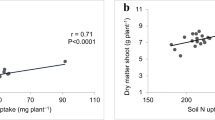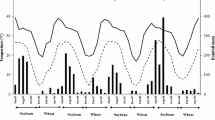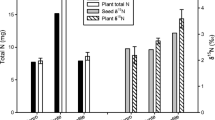Abstract
Biological nitrogen fixation (BNF) of 17 soybean cultivars was comparatively estimated by the δ15N natural abundance technique using two non-nodulation soybeans (Clay and Chippewa) as reference plants. A field study was established on the experimental farm of the University of Abomey-Calavi, Benin on a typical “terre de barre” soil classified by Food and Agriculture Organization-United Nations Educational, Scientific and Cultural Organisation as Rhodic Ferralsol. A nitrogen-free pot trial was also carried out using soil substrate sampled from the Atlantic Ocean beach. In the N-free medium, N content of the whole soybean cultivars ranged from 2.6 to 8.1 mg N per plant compared with an average of 1.8 mg N per plant observed with the non-fixing soybeans. Plant δ15N of the nodulating soybeans ranged from −2.7756‰ (Jupiter) to 0.1951‰ (Conquista), while the non-nodulating cultivars Chippewa and Clay had 2.67‰ and 9.30‰, respectively. Percentage and amount of N derived from air (Ndfa) were significantly different (P < 0.01) among soybean cultivars, and values depended highly on the selected reference plants. When Clay was used as the reference plant, the average percentage Ndfa was 1.4 times higher than when Chippewa was the reference plant. Both reference plants consistently ranked promiscuous soybean cvs. TG× 1894 3F and TG× 1908 8F as the best cultivars and cv. TG× 1888 29F as the least in percentage Ndfa, suggesting that any of the reference plants could be used in δ15N method for assessing N2-fixation. The two identified promiscuous soybean cultivars with greatest capacity to fix N could be included in a soybean extension program for West African farming systems.
Similar content being viewed by others
References
Amarger N, Mariotti A, Mariotti F, Durr JC, Bourguignon C, Lagacherie B (1979) Estimate of symbiotically fixed nitrogen in field grown soybeans using variations in 15N natural abundance. Plant Soil 52:269–280 doi:10.1007/BF02184565
Annual Report DPP/MAEP (2005) Rapport annuel DPP:MAEP République du Bénin
Barrie A, Debney S, Workman CT, Pullan C (1995) Recent developments in high productivity stable isotope analysis. In: International Symposium on Nuclear and Related Techniques in Soil–Plant Studies for Sustainable Agricultural and Environmental Preservation. Vienna (Austria), 17–21 Oct 1994. IAEA TECDOC Vienna, Austria, pp. 29–61
Bekunda MA, Bationo A, Ssali H (1997) Soil fertility management in Africa: A review of selected research trials. In: Buresh RJ et al. (eds) Replenishment soil fertility in Africa. SSSA Spec. Publ. 51, SSSA, Madison, W1, USA, pp. 63–79
Bergersen FJ, Peoples MB, Turner GL (1988) Isotopic discrimination during the accumulation of nitrogen by soybeans. Aust J Plant Physiol 15:407–420
Bergersen FJ, Brockwell J, Gault RR, Morthorpe L, Peoples MB, Turner GL (1989) Effects of available soil nitrogen and rates of inoculation on nitrogen fixation by irrigated soybeans and evaluation of 15N methods for measurement. Aust J Agric Res 40:763–780 doi:10.1071/AR9890763
Boddey RM, Peoples MB, Palmer B, Dart PJ (2000) Use of the δ15N natural abundance method to quantify biological nitrogen fixation in woody perennials. Nutr Cycl Agroecosyst 57:235–270 doi:10.1023/A:1009890514844
Chapman AL, Myers RJK (1987) Nitrogen contributed by grain legumes to rice grown in rotation on the Cununurra soils of the Ord irrigation area, Western Australia. Aust J Exp Agric 27:155–163 doi:10.1071/EA9870155
Danso SKA, Bowen GD, Sanginga N (1992) Biological nitrogen fixation in trees in agro-ecosystems. Plant Soil 141:177–196 doi:10.1007/BF00011316
Danso SKA, Hardarson G, Zapata F (1993) Misconceptions and practical problems in the use of δ15N soil enrichment techniques for estimating N2 fixation. Plant Soil 152:25–52 doi:10.1007/BF00016331
Doughton JA, Saffigna PG, Vallis I, Mayer RJ (1995) Nitrogen fixation in chickpea. II Comparison of δ15N enrichment and δ15N natural abundance methods for estimating nitrogen fixation. Aust J Agric Res 46:225–236 doi:10.1071/AR9950225
Gathumbi SM, Cadish G, Giller KE (2002) 15N natural abundance as a tool for assessing N2 fixation of herbaceous, shrub and tree legumes in improved fallows. Soil Biol Biochem 34:1059–1071 doi:10.1016/S0038-0717(02)00038-X
Giller KE (2001) Nitrogen fixation in tropical cropping systems. 2nd Edn, p 423
Handley LL, Raven JA (1992) The use of natural abundance of nitrogen isotopes in plant physiology and ecology. Plant Cell Environ 15:965–985 doi:10.1111/j.1365-3040.1992.tb01650.x
Handley LL, Scrimgeour CM (1997) Terrestrial plant ecology and 15N natural abundance: the present limits to interpretation for uncultivated systems with original data from a Scottish old field. Adv Ecol Res 27:133–212 doi:10.1016/S0065-2504(08)60008-2
Hardarson G, Bliss FA, Cigales-Rivero MR, Henson RA, Kipe-Nolt JA, Longeri L et al (1993) Genotypic variation in biological nitrogen fixation by common bean. Plant Soil 152:59–70 doi:10.1007/BF00016333
Herridge DF, Holland JF (1992) Production of summer crops in northern New South Wales1. Effects of tillage and double cropping on growth, grain and N yields of six crops. Aust J Agric Res 43:105–122 doi:10.1071/AR9920105
Herridge DF, Marcillos H, Felton WL, Turner GL, Peoples MB (1995) Chickpea increases soil N fertility in cereal systems through nitrate sparing and N2 fixation. Soil Biol Biochem 27:545–551 doi:10.1016/0038-0717(95)98630-7
Högberg P (1997) δ15N natural abundance in soil–plant systems. New Phytol :179 doi:10.1046/j.1469-8137.1997.00808.x
Houngnandan P (2006) Response of promiscuous soybean to rhizobial inoculation and fertilization treatments and their effects on subsequent maize yields in degraded “terre de barre” in Benin. In: Management practices for improving sustainable crop production in tropical acid soils: results of a coordinated research project organized by the joint FAO: IAEA programme on nuclear techniques in food and agriculture, IAEA, 2006 STU/PUB/1285; pp 325–338
Houngnandan P, Manyong VM, Sanginga N, Vanlauwe B, Diels J, Van Cleemput O (2005) Farm-level use of soil amendments and definition of typologies: implications for the design of balanced nutrient management systems in the derived savanna of the Republic of Benin. Ann Sci Agron Ben 1(7):111–133
Kohl DH, Shearer G, Harper JE (1980) Estimates of N2 fixation based on differences in the natural abundance of 15N in nodulating and non-nodulating isolines of soybeans. Plant Physiol 66:61–65
Kueneman EA, Root WR, Dashiell KE, Hohenberg J (1984) Breeding soybeans for the tropics capable of nodulating effectively with indigenous Rhizobium spp. Plant Soil 82:387–396 doi:10.1007/BF02184276
Letolle R (1980) Nitrogen-15 in the natural environment. In: Fritz P, Fontes JC (eds) Handbook of environmental geochemistry. Elsevier, Amsterdam, pp 407–433
Mariotti A, Mariotti F, Amarger N (1983) Use of natural 15N abundance in the measurement of symbiotic fixation. Nuclear techniques in improving pasture management. International Atomic Energy, Vienna, Austria, pp 61–77
Maskey S, Bhattari S Peoples MB, Herridge DF (1997) Nitrogen fixation by winter and summer legume crops in the hill and terai regions of Nepal. In: Rupela OP, Johansen C, Herridge DF (Eds) Extending Nitrogen Research to Farmers’Fields: Proceedings of an International Workshop on Managing Legume Nitrogen Fixation in cropping Systems of Asia. ICRISAT, Hyderabad, India, pp. 361–371
Nguluu SN, Probert ME, McCown RL, Myers RJK, Waring SA (2001) Isotopic discrimination associated with symbiotic nitrogen fixation in stylo (Stylosanthes hamata L.) and cowpea (Vigna unguiculata L.). Nutr Cycl Agroecosyst 62:11–14 doi:10.1023/A:1015440906428
Norris DO, Date RA (1976) Legume Bacteriology Tropical Pasture Research. Principles and Methods. Bulletin Commonwealth Bur. Past. Fld. Crops N° 11. p 76
Oikeh SO, Houngnandan P, Abaidoo RC, Rahimou I, Toure A, Niang A, et al (2008) Integrated soil fertility management involving promiscuous dual-purpose soybean and upland NERICA enhanced rice productivity in the savannas. Nutr Cycl Agroecosyst (in press). doi:10.1007/s10705-008-9185-z
Okereke UG, Eaglesham ARJ (1993) Nodulation and nitrogen fixation by 79 “promiscuous” soybean genotypes in a soil in Eastern Nigeria. Agro. Fr. 5:123–135
Okito AB, Alves RJ, Urquiaga S, Boddey RM (2004) Isotopic fractionation during N2 fixation by tour tropical legumes. Soil Biol Biochem 36:1179–1190 doi:10.1016/j.soilbio.2004.03.004
Osunde AO, Gwam MS, Bala A, Sanginga N, Okogun JA (2003) Responses to rhizobial inoculation by two promiscuous soybean cultivars in soils of the Southern Guinea savanna zone of Nigeria. Biol Fertil Soils 37:274–279
Peña-Cabriales JJ, Grageda-Cabrera OA, Kola V, Hardarson G (1993) Time course of N2 fixation in common bean (Phaseolus vulgaris L.). Plant Soil 152:115–121 doi:10.1007/BF00016340
Peoples MB, Herridge DF (1990) How much nitrogen is fixed by legumes? Agric Sci 3:24–29
Peoples MB, Faizah AW, Rerkasem B, Herridge DF (1989) Methods for evaluating nitrogen fixation by nodulated legumes in the field. ACIAR, Canberra, Australia Monograph N°11, p 76
Pulver EL, Kueneman EA, Ranarao V (1985) Identification of promiscuous nodulating soybean efficient in N2 fixation. Crop Sci 25:660–663
Sanginga N, Abaidoo R, Dashiell K, Carsky RJ, Okogun JA (1996) Persistence and effectiveness of rhizobia nodulating promiscuous soybeans in moist savanna zones of Nigeria. Appl Soil Ecol 3:215–224 doi:10.1016/0929-1393(95)00089-5
Sanginga N, Thottappilly G, Dashiell K (2000) Effectiveness of rhizobia nodulating recent promiscuous soybean selections in the moit savanna in Nigeria. Soil Biol Biochem 32:127–133 doi:10.1016/S0038-0717(99)00143-1
SAS (2001) SAS/STAT user’s guide. Version 8.2 for Windows. SAS Institute, Cary, NC, USA
Shearer G, Kohl DH (1986) N2-fixation in field settings: estimations based on natural δ15N abundance. Aust J Plant Physiol 13:699–756
Shearer G, Kohl DH, Harper JE (1980) Distribution of 15Namong plant parts of nodulating and non-nodulating isolines of soybeans. Plant Physiol 66:57–60
Somado EA, Kuehne RF (2006) Appraisal of the 15N-isotope dilution and 15N natural abundance methods for quantifying nitrogen fixation by flood-tolerant green manure legumes. Afr J Biotechnol 12:1210–1214
Spriggs AC, Stock WD, Dakora FD (2003) Influence of mycorrhizal associations on foliar delta N-15 values of legume and non legume shrubs and tree in the fynbos of South Africa: Implications for estimating N2 fixation using the 15N natural abundance method. Plant Soil 255:495–502 doi:10.1023/A:1026044831178
Steele KW, Bonish PM, Daniel RM, O'Hara GW (1983) Effect of rhizobial strain and host plant on nitrogen isotopic fractionation in legumes. Plant Physiol 72:1001–1004
Unkovich MJ, Pate JS, Sanford P, Armstrong EL (1994) Potential precision of the δ15N natural abundant method in field estimates of nitrogen fixation by crop and pasture legumes in South-West Australia. Aust J Agric Res 45:119–132 doi:10.1071/AR9940119
Vincent JM (1970) A Manual for the Practical Study of Root Nodule Bacteria.
Yoneyama T, Yamada N, Kojima H, Yazaki J (1984) Variation of natural 15N abundance in leguminous plants and nodule fraction. Plant Cell Physiol 25:1561–1565
Yoneyama T, Fujita K, Yoshida T, Matsumoto T, Kambayashi I, Yazaki J (1986) Variations in natural abundance of δ15N among plant parts and in δ15N/14N fractionation during N2 fixation in the legume–rhizobia symbiotic system. Plant Cell Physiol 27:791–799
Acknowledgments
The authors are grateful to the VLIR Own Initiative Project entitled “Restoration of soil fertility in the south and centre of Benin” funded by the Belgian government which provided funding and offered laboratory facilities through training in Ghent University to support soil and plant analysis.
Author information
Authors and Affiliations
Corresponding author
Rights and permissions
About this article
Cite this article
Houngnandan, P., Yemadje, R.G.H., Oikeh, S.O. et al. Improved estimation of biological nitrogen fixation of soybean cultivars (Glycine max L. Merril) using 15N natural abundance technique. Biol Fertil Soils 45, 175–183 (2008). https://doi.org/10.1007/s00374-008-0311-5
Received:
Revised:
Accepted:
Published:
Issue Date:
DOI: https://doi.org/10.1007/s00374-008-0311-5




